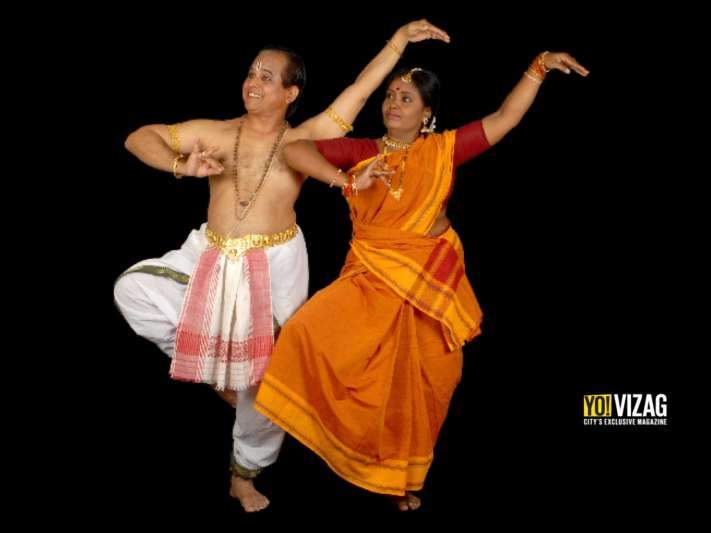Guru Potnuru Vijaya Bharani Shenkar, and his wife Chetana, are third generation Kuchipudi dancers from Visakhapatnam. As they keep the tradition alive and their son Uday Shenkar takes it forward into the fourth generation, they talk about the past and the future of this dance form.
Looking back
Art is part of his family tradition, which started with the forefathers of Bharani Shenkar. His grandfather, Late Potnuru Venkata Swami was a Harikatha narrator in Visakhapatnam, while his father would assist him on the harmonium. However, in the 30s, his father Late Venkata Narasimha Rao, learned the classical dances and went on to become ‘Nataraja Hamsa’, ‘Bahukala Kovida’ and ‘Natya Praveena’ in Bharatanatyam and Kuchipudi. In 1947, Venkata Narasimha started his academy Nataraja Hamsa Natya Kalamandir at Maharanipeta in Visakhapatnam. Having gained recognition by AP Sangeet Natak Academy in 1962, the academy grew in Chengalaraopeta. It became a 35 room building and ran diploma courses.
Venkata Narasimha even taught dance to the famous film stars of yesteryears. Exposed to music and dance at an impressionable age, Bharani Shenkar too learned under his father for a while, and then at the age of nine, shifted to Chennai, to train under Kuchipudi exponents Vempati Pedda Satyam and Vempati Chinna Satyam. Adapting techniques, and learning folk dances as well, he went on to establish his own academy, Sri Ambikeshwara Kuchipudi Dance and Music Academy in 1982. Recognised as the ‘National Second Generation guru’ by the cultural department of AP government in 1997, 55 years of experience has brought him many awards, recognition and titles of ‘Nrithya Kalathapaswi’ and ‘Natyakala Prapoorna’.
Guiding The Partner
His betrothal to Chetana, in 1983, was also a marriage of the arts. Hailing from a family of Bharatanatyam dancers, Chetana came under the tutelage of Bharani Shenkar and learnt his unique style of Kuchipudi. Today she takes classes for the young ones as well. “She’s attached to the kids like a mother, often feeding the students who come here as well.” Talking about her role, she shares that she finds great joy in this work. “Master Garu takes theory classes, while I take the practical sessions for smaller kids. It is easy to balance the dual roles at home”, she shares. While their work gives them a good amount of time to spend together, they do often go out and prefer the second shows at movies. “There are 64 kalalu (arts) and movies are a great depiction of a variety of characters. Mannerisms, psychology etc. are showcased wonderfully here, and they teach us how to portray any character easily”, he shares.
Joy of Teaching
Both husband and wife derive immense satisfaction from teaching. Talking about trends they share that today many tend to focus on performance rather than learning. “Learners of classical dance shouldn’t focus on performance, but on learning. So students enrolling at Sri Ambikeshwara are counselled along with parents, that the process of learning would take up to 20 years. Not restricting to only the young, he also teaches the older people, focusing less on footwork and more on abhinaya. “This art is anantam, it is endless and has so much to teach”, he shares.
Memorable Performances
He reminisces of the time when the cyclone had devastated the city. “I had accepted to do a ballet for a programme at Singapore. However even before I put pen to paper, cyclone Hudhud struck.” However, the commitment, made him push himself and despite lack of electricity, food, water, even candles, he’d sit for hours on the ballet design. Finally, once trains begin to move, he headed to Hyderabad and finished his work at Sobha Naidu’s Academy. The Sri Krishna tulabharam depiction at Singapore got a standing ovation. And the effort that the entire team put into it made it well worth the effort.
Dream project
The couple shares the same dream of the completion of their academy building in Visakhapatnam. “My journey has been one of struggle, and I know the value of taking the Kuchipudi art forward.” Chetana nods her head too, “Master garu struggled a lot in his early life, and it has all been for this dream.” If achieved, it would make it easier for them to take classes and also provide accommodation for students who want to come from abroad and learn.
This art is anantam, it is endless and has so much to teach.










Discussion about this post